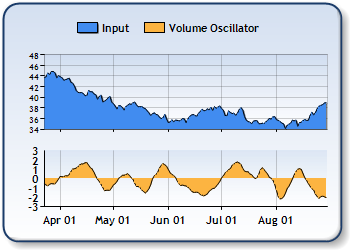Overview

The Volume oscillator attempts to identify trends in volume by comparing two moving averages; one with a short period and another with a longer period.
 Note Note |
|---|
| We recommend that you read Using Financial Formulas before proceeding any further. Using Financial Formulas provides a detailed explanation on how to use formulas, and also explains the various options available to you when applying a formula. |
 |
|
Figure 1: The Volume Oscillator in the lower chart area. The Volumes are plotted in the upper chart area as an Area chart. |
Applying Volume Oscillator
All financial formulas are calculated using the FormulaFinancial method, which accepts the following types of arguments: a formula name; input value(s); output value(s), and parameter(s) that are specific to the type of formula being applied.
Also, before applying the FormulaFinancial method, make sure that all data points have their XValue property set, and that their series' XValueIndexedproperty has been set to false.
The following table indicates what sort of FormulaFinancial method arguments to use when calculating a Volume Oscillator, and also supplies a description of what these parameters mean:
| Parameter |
Value/Description |
Example |
|---|---|---|
| Formula Name: |
VolumeOscillator
|
FormulaFinancial(FinancialFormula.VolumeOscillator,"10,30,true","Series1:Y","Series3:Y") |
| Input Values: | The value which presents Volume. |
FormulaFinancial(FinancialFormula.VolumeOscillator,"10,30,true"," Series1:Y","Series3:Y") |
| Output Value: (optional) |
The Volume Oscillator. If not specified output is stored in the first input value. |
FormulaFinancial(FinancialFormula.VolumeOscillator,"10,30,true","Series1:Y"," Series3:Y") |
|
Parameters: |
Parameter #1: Short Period - Period for shorter Moving Average (Default value is 5).
Parameter #2: Long Period - Period for longer Moving Average (Default value is 10).
Parameter #3: Percentage - The Volume Oscillator can display the difference between the two moving averages as either points or percentages. (Default value is true which means percentages). |
FormulaFinancial(FinancialFormula.VolumeOscillator,"10,30,true","Series1:Y","Series3:Y") |
A line chart is a good choice when displaying a Volume Oscillator series.
Financial Interpretation: The Volume oscillator measures the difference between a long period moving average of volume and a short period moving average of volume.
If the volume oscillator is positive then the short period moving average is above the long period moving average, and this signals a strong trend. If the volume oscillator is negative then the short period moving average is below the long period moving average, and this signals a trend weakness.
Calculation: The Volume oscillator can be calculated in percentages or in absolute values. If percentage is used:
VO = (( Short MA - Long MA ) / Short MA) * 100
Where MA presents Moving Average of volume.
If percentage is not used:
VO = Short MA - Long MA
Example
This example demonstrates how to calculate Volume Oscillator.
| Visual Basic |  Copy Code Copy Code |
|---|---|
| |
| C# |  Copy Code Copy Code |
|---|---|
| |




